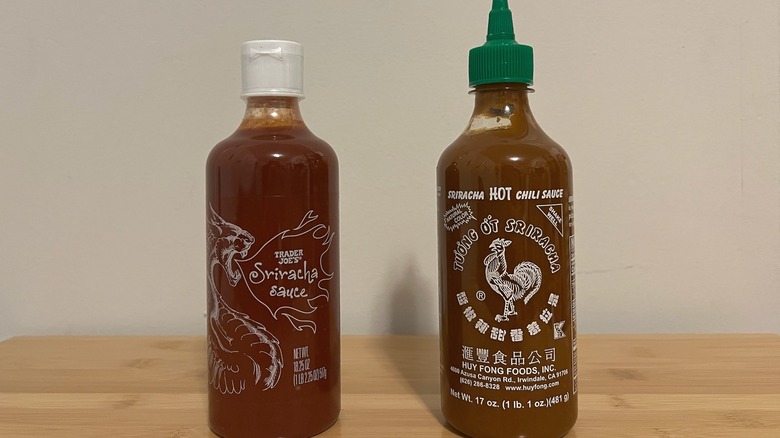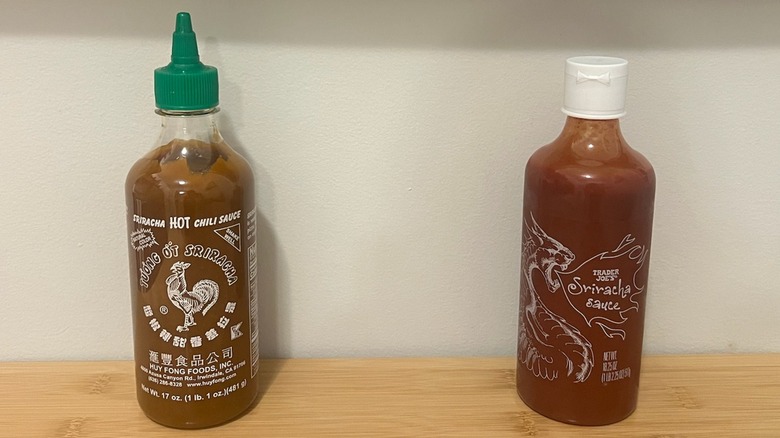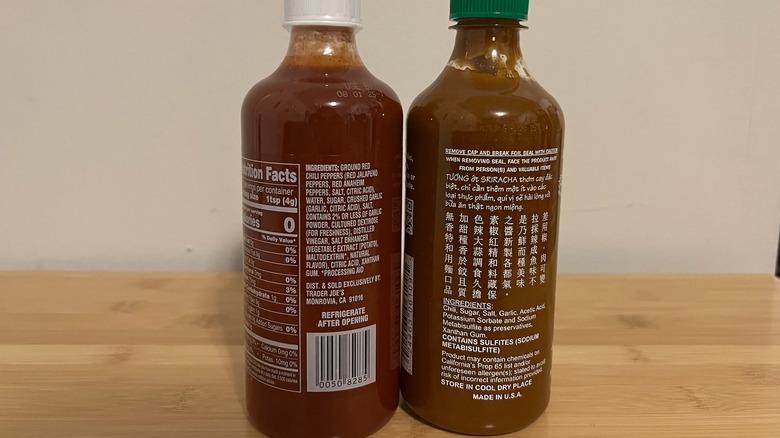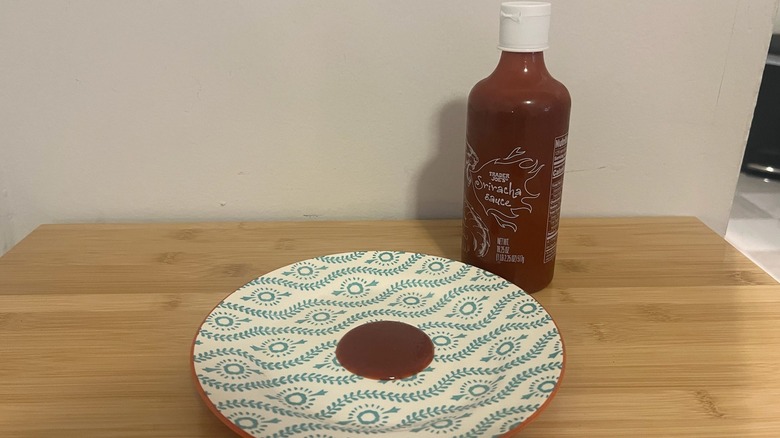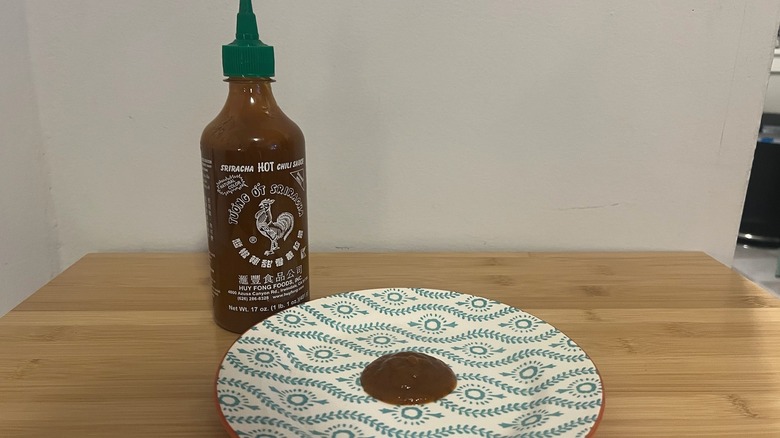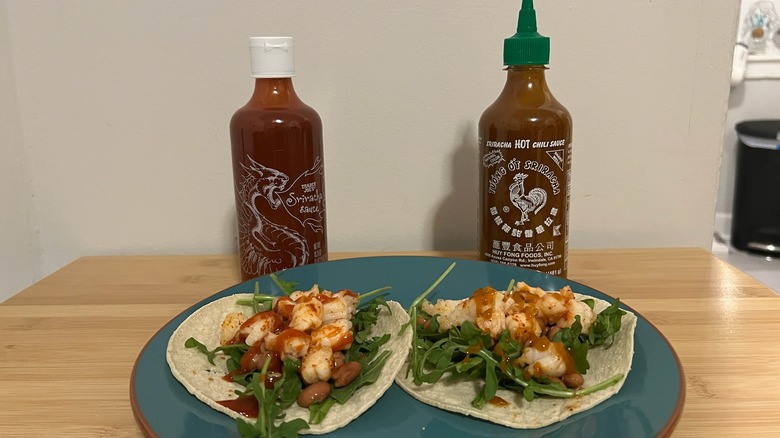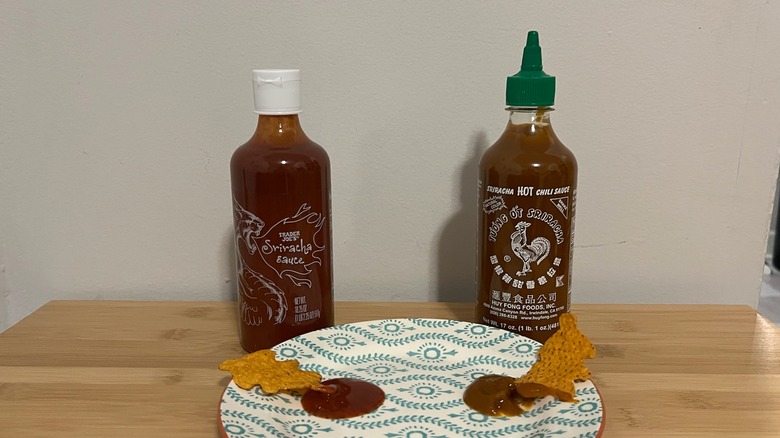Trader Joe's Sriracha Vs Huy Fong: Which Tastes The Best?
We may receive a commission on purchases made from links.
If you're a lover of spicy food, you've probably had sriracha. Its origins are traced back to 1949 in a town in Thailand called Si Racha. That's where the first iteration of the hot sauce started, however, the current version that we know today was brought over to the United States by a Vietnamese man named David Tran. Tran created a delicious sauce with jalapeño chilis, salt, garlic, and other seasonings.
Tran is the founder of Huy Fong, the first sriracha brand to hit the U.S., and found on the tables of many Thai, Vietnamese, and even American chain restaurants around the country. People obsess over this sauce, and there was even a major Huy Fong sriracha shortage in 2022. Known for its extremely spicy characteristics, many spice-lovers can't go a day without using Huy Fong sriracha on at least one of their meals.
Trader Joe's, the beloved grocery store that has its own cult following, has its own sriracha. It's strategically served in a bottle that doesn't look too far off from Huy Fong's, but the contents on the inside are not quite the same. I was extremely curious to see if Trader Joe's interpretation of the sauce tasted better than the fan-favorite Huy Fong original, so I decided to take matters into my own hands and did an ultimate taste test to see which sauce came out on top.
Price and availability
Huy Fong sriracha is found in almost any grocery store, and it's easy to find in aisles housing other flavor-boosting sauces like barbecue, buffalo sauce, and ketchup. When I went to pick up a 17-ounce bottle at my local grocery store in New York City, it cost $6.99. However, prices vary online. At Walmart, in both a suburban New Jersey town and the big city of Miami, Huy Fong sriracha is priced at $4.72 for the same size, though I've seen the price go as high as $8.99. Amazon prices for the 17-ounce bottle are wide and varied, but the lowest I've seen is $6.49.
Trader Joe's sriracha is much more affordable for 18.25 ounces. I was able to snag my bottle in a New York City TJ's for $3.99. The major downside, however, is that Trader Joe's trips can be quite the "to do," as there's a true technique to shopping at Trader Joe's. Especially if you live in a city, you know that you can't really just pop into Trader Joe's to pick up an item or two. The lines tend to wrap around the store, and you sometimes have to perform shopping cart Olympics to cross an aisle. So, even though the sriracha is cheaper at Trader Joe's, it's not very easy to get in a pinch.
Ingredients and nutrition information
Before I went ahead with my taste test, I wanted to see if the bottles varied in nutritional value or ingredients. The nutrition panels look almost exactly the same from brand to brand. Both sauces have zero calories. They each have a little bit of sodium, however, Trader Joe's has about 5 milligrams more than Huy Fong. Though, Huy Fong has six more grams of potassium than Trader Joe's. From that information alone, I was curious to see if the sauces tasted that different from each other, seeing they had almost the same nutritional makeup.
As for the ingredients, it's a little hard to gauge. Trader Joe's sriracha looks like it has a longer list of ingredients, but when looking closer, TJ's just adds more detail. The first ingredient listed for both sauces is chili. However, TJ's says "ground red chili peppers (red jalapeño peppers, red Anaheim peppers, salt, and citric acid)," and Huy Fong simply says "chili." Upon further research, Huy Fong makes its sauce mainly from grinding fresh chili peppers. Both sauces also have vinegar, garlic, sugar, and salt.
The overall impression I got looking at both sriracha bottles was that Trader Joe's sriracha may taste a bit fresher due to the details added to the label on the bottle. Huy Fong is a bit more secretive, and glancing at the bottle, it doesn't seem like the ingredients are that fresh.
Taste test: Trader Joe's sriracha
To start my taste tests, I had each sriracha on a plate completely by itself. Trader Joe's sriracha surprised me at first because it had a very strong ketchup-like flavor to it. Considering there were no tomatoes listed on the ingredients, that was a bit odd. The sauce itself was very thin (almost watery) and had a deep red color.
The next thing I noticed was that the sauce wasn't incredibly spicy. I was always under the impression that sriracha is one of the hottest types of sauce out there, and Trader Joe's sriracha was definitely underwhelming in that sense. Out of 10 on my personal spice scale, I'd give the sauce a solid 4. The sriracha also had a smoky aspect, which matched its earthy and deep scent.
I then tried the sauce as a dip for a plain tortilla chip and found it pretty enjoyable. The smoky and not-too-spicy flavor was perfect for a dip. Then, I tried the sauce on a piece of grilled shrimp. I found the Trader Joe's sriracha a bit too ketchup-flavored for the shrimp, and it didn't mesh well. Lastly, I tried it on a shrimp taco, and while it was enjoyable, it was still a little too smoky and ketchup-like for a topping on seafood.
Taste test: Huy Fong sriracha
As I set up the Huy Fong sriracha, I immediately noticed the complete difference in consistency and color compared to the Trader Joe's sriracha. Huy Fong's is much lighter, almost like a muted red. It's also incredibly thick and comes off more as a dip than a drizzly sauce. It smelled a lot lighter than Trader Joe's, but I could also feel a slight burn in my nostrils when I took a whiff.
As I tasted the sauce by itself, I was immediately hit with a huge kick of spice. This sriracha had about double the spice of the Trader Joe's. It completely burned my mouth up, but in a great way (spicy foods are my weakness). This sauce had absolutely no flavorings similar to ketchup, and instead, it came off extremely peppery. I could tell that the meat of the chili peppers was inside the sauce, and it had a great flavor. When I tasted the sauce with the chip, I did think that it was a little too spicy as a dip by itself. However, once the shrimp came in, it was game over. This sauce was absolutely perfect for a seafood dip or topping because its light pepperiness matched the heat. It was almost reminiscent of shrimp cocktail sauce. Lastly, it was perfect for the shrimp taco as well. The sauce fitted right into that flavor profile.
Which is better?
I was incredibly surprised to see how different these two sauces tasted. If I am being completely honest, I wouldn't even consider Trader Joe's true sriracha sauce, knowing that Huy Fong is the standard original. It had a completely different texture, flavor profile, and heat level. However, Britannica describes sriracha as a "bright red hot sauce of Thai origin made of chili peppers, vinegar, garlic, salt, and sugar," so technically, Trader Joe's sriracha still fits into the category.
I will say that I found the Trader Joe's sriracha to still taste great, but once I compared it to Huy Fong, there was no contest. I think that there is definitely a time and a place for Trader Joe's sriracha, especially for foods that call for a not-as-spicy flavor profile, like a smoky vegetable stir fry. Huy Fong, on the other hand, is great for a larger variety of dishes.
Ultimately, Huy Fong was the clear winner here. Nobody, not even my beloved Trader Joe's, can beat out a classic. People who are true spice lovers will definitely agree with my stance. The intense spiciness, delicious peppery freshness, and thick consistency just can't be beaten. Although this sauce is a bit more expensive, it's easy to access and is worth the extra money.
Methodology
When tasting both sriracha sauces, I wanted to be able to fairly compare the two. First, I tasted each one individually, without any other food involved. I took a big sip of water and cleared my mouth in between each bite, just to make sure I was getting a fair sense of each brand's flavor. Then, I tried the sauces with other ingredients to see how the flavors changed: a plain tortilla chip, a piece of grilled shrimp, and a shrimp taco with beans and arugula on a corn tortilla. From there, I was able to notice different aspects of the sauce's flavorings and was able to make a clear decision on the winner.
